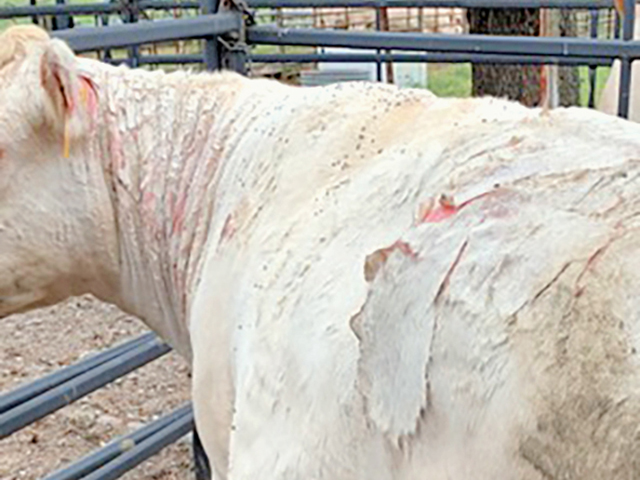Ask the Vet
Cattle Diet Is Primary Cause of Photosensitization
DTN is rerunning this column from our archives because it's still relevant and useful advice.
**
READER QUESTION:
We had a Charolais cow with large patches of skin on her head and back. They are scabbed over and look like they are peeling up around the edges. She is in good body condition and does not seem sick. What could this be?
P[L1] D[0x0] M[300x250] OOP[F] ADUNIT[] T[]
DR. KEN MCMILLAN'S ANSWER:
This sounds like photosensitization. I have described it in this column before as a chemical sunburn. It is more common on light skin and the mucus membranes.
There are two forms of photosensitization. Primary photosensitization is due to the consumption of a plant that contains photodynamic agents. These are absorbed into the bloodstream and travel to the skin. Ultraviolet (UV) light activates them and creates a severe inflammatory reaction in the skin. Plants most commonly associated with this condition include St. John's wort, buckwheat and smartweed.
Secondary photosensitization is far and away the most common form we see. With this condition, the liver is damaged from something the animal ate or some type of liver disease. Chlorophyll from plants the cow eats is broken down into phylloerythrin and excreted by the liver in bile. With liver damage, phylloerythrin builds up in the bloodstream and the skin. It is activated in the skin by UV light, creating skin lesions. Plants most associated with this form include alsike clover, comfrey, rattlebox, fiddleneck and ragwort.
Treatment involves removing animals from the pastures containing the plants causing the problem and protecting them from sunlight. If the teats of cows are affected, they may not allow calves to nurse. In those cases, calves will need supplementation until the cows recover. In some cases, antibiotics may be needed if the skin becomes infected.
**
Editor's Note: Please contact your veterinarian with questions about the health of your herd or other animals. Every operation is unique, and the information in this column does not pertain to all situations. This is not intended as medical advice but is purely for informational purposes. Email Dr. Ken McMillan at vet@dtn.com.
(c) Copyright 2025 DTN, LLC. All rights reserved.






